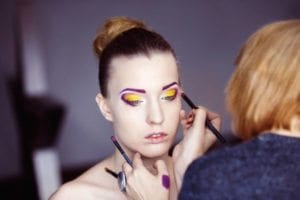Make-Up Artists fall into the Strong Interest Inventory® Test Artistic Theme Code Category. The Strong Interest Inventory®, first released in 1927, has been refined over the better part of a century. It analyzes and categorizes careers based on the interests and preferences of people who tend to pursue them, and then assesses individuals’ attributes to help them find an ideal career. Careers in the Artistic Theme Code generally involve creating something in the workplace, from visual art to performances, and written documents to food. Individuals who score high in the Artistic Theme Code Category enjoy activities which give them a creative outlet, both in their vocational pursuits and in their personal lives.
Theatrical and performance Makeup Artists work closely alongside stage or motion picture officials, directors, costume designers, and performers to determine desired effects for visual makeup. They often work for films, musical productions, theatrical shows, television studios, and other venues for which a performer’s individual appearance needs to be altered to make a character come to life. Designing make up plans also involves reading the script closely and noting any events that may cause a physical change in character’s appearance. As they begin the design process, they may need to produce sketches, mock-ups, photographs, storyboards, etc.They need to procure the necessary materials for creating the desired effects, and must be able to design their operations within prescribed budgetary limitations. Once the visuals are designed, they must be able to implement them by applying makeup or prostheses to alter an actors appearance in films. They need to take into account lighting, skin tone, sensitivity to certain chemicals or other products, and other considerations that may alter an individual character’s makeup. They must be able to duplicate their efforts exactly across multiple days to maintain consistency of the character.
Makeup hardware and software may include air brushes, contact lenses of various colors, wigs and other costuming accessories, eyebrow and hair combs, standard makeup kits (including eye shadow brushes, fan brushes, round brushes, sponges, etc.), pencils and pencil sharpeners, and hair and hand sprayers. In addition, they may need palette or blending spatulas, knives and brushes, as well as mixing palettes for paint or ink. Many Makeup Artists also use graphics or photo software, including Adobe Photoshop, DatInf DigiMakeup, SavingFace, and others, to design and finalize their visions. Many also maintain their own brands on social media (Facebook, Instagram, personal blogs) and keep track of their own accounts (clearbooks, Intuit QuickBooks) and appointments. Mastery of social media, internet interfaces, web design interfaces (e.g., Google Sites, WordPress) and Microsoft Office are all essential for Makeup Artists.

Read about a Makeup Artist’s career including information such as a Makeup Artist’s salary, daily tasks and other career information.
Most Makeup Artists attend vocational school, though a college Bachelor or Masters Degree is rarely necessary for success. Considerate and confident personal and customer service, and a detailed talent and knowledge for the fine arts and design are by far the most important characteristics of a successful Makeup Artist. The ability to communicate quickly and clearly, as well as make confident decisions, often very quickly, is also highly valued. Makeup artists work closely with other team members, actors, directors, and so on, and need to be kind, compassionate, and flexible, and be able to adapt to unforeseen circumstances with ease. The ability to build close relationships is important because these connections often lead to additional jobs, not to mention a better experience, and therefore a more positive reputation. Physical dexterity and precision is essential for applying makeup and producing sketches and other images for presentation. Hand-arm steadiness, manual and finger dexterity, and near vision are of the utmost importance, as without any of these, an application session can go terribly wrong.
Nation-wide, a Makeup Artist’s Salary is, on average, $53,230 annually, though the top 30% in the country average $122,110 per year. Local theaters or television production companies pay makeup artists as low as $19,000. The most lucrative states are New York and California by a considerable margin, with Texas, Tennessee, and Florida also having averages above $30,000. Little data is available in the central or Midwestern United States, or in New England. While employment rates are expected to increase by 20% before 2024, this is only from 3,600 to 4,300 jobs, so the world of makeup design is still a highly competitive one.
Below are some employment trends for performance Makeup Artists:
- Median Makeup Artist Salary: $25.59/hour; $53,230 annually
- Employment: 4,000 employees
- Projected growth (2014-2024): much faster than average (Greater Than 14%)
- Projected job openings (2014-2024): 1,000
Visit Our Strong Interest Inventory® Resource Page
Visit Our Myers-Briggs Type Indicator® Career Resource Database for Information on MBTI® Personality Type Careers
To Learn More About the Myers-Briggs Type Indicator, visit our About MBTI Test Page
Gain access to your best-fit careers, occupational preferences and interests with these career based Strong Interest Inventory® Assessments:
-
MBTI® Career Report + Strong & MBTI Combined Career Report + Strong Profile
Price: $96.95 Buy NowDIGITAL DELIVERY
- Three of the top career-focused tests included
- Designed to uncover the best career fit for your true self
- Links to complete assessments are sent digitally via email within 2-3 business hours of purchase
- Results sent in PDF form via email within 6-8 business hours
Download Sample MBTI® Career Report
Download Sample Strong & MBTI® Combined Career Report Plus Strong Profile
Download Sample Strong Interest Inventory® Profile Report
-
Strong Interest Inventory® Interpretive Report
Price: $64.95 Buy NowDIGITAL DELIVERY
- This report starts with the same foundation as the Strong Interest Inventory Profile but goes even further into analyzing your likes and dislikes and how that can help you lead a more fulfilling, satisfied life
- Dive deeper into what your interests, hobbies, favorite topics, and vocations could mean for your career and personal life
- Links to complete assessments are sent digitally via email within 2-3 business hours of purchase
- Results sent in PDF form via email within 6-8 business hours
Download sample Strong Interest Inventory® Interpretive Report
-
Strong Interest Inventory® Profile
Price: $54.95 Buy NowDIGITAL DELIVERY
- Set yourself up for success by choosing a career that reflects your personal interests, preferences, likes, and dislikes
- This test compares your preferences against professionals actively in specified industries, rather than basing results on theory alone
- Links to complete assessments are sent digitally via email within 2-3 business hours of purchase
- Results sent in PDF form via email within 6-8 business hours
-
Strong Interest Inventory® & Skills Confidence Profile + Strong Interpretive Report
Price: $72.95 Buy NowDIGITAL DELIVERY
- Better understand your strengths, interests, preferences, and areas of confidence
- Connect your innate traits to a successful and satisfying career
- Links to complete assessments are sent digitally via email within 2-3 business hours of purchase
- Results sent in PDF form via email within 6-8 business hours
Download sample Strong Interest Inventory® & Skills Confidence Profile + Strong Interpretive Report
-
iStartStrong™ Report
Price: $39.95 Buy NowDIGITAL DELIVERY
- Plan your future career based on your interests and passion
- Start on the right path to finding a career that you’ll enjoy for years to come
- Links to complete assessments are sent digitally via email within 2-3 business hours of purchase
- You will be able to self-download your report as a PDF document immediately following the completion of your assessment.
Explore our Strong Interest Inventory® Blog Pages:
- Strong Interest Inventory Realistic Theme Explained
- Strong Interest Inventory Artistic Theme Explained
- Strong Interest Inventory Investigative Theme Explained
- Strong Interest Inventory Social Theme Explained
- Strong Interest Inventory Enterprising Theme Explained
- Strong Interest Inventory Conventional Theme Explained
Assessment Categories
References
- Bureau of Labor Statistics wage data and 2012-2022 employment projections Onetonline.org














